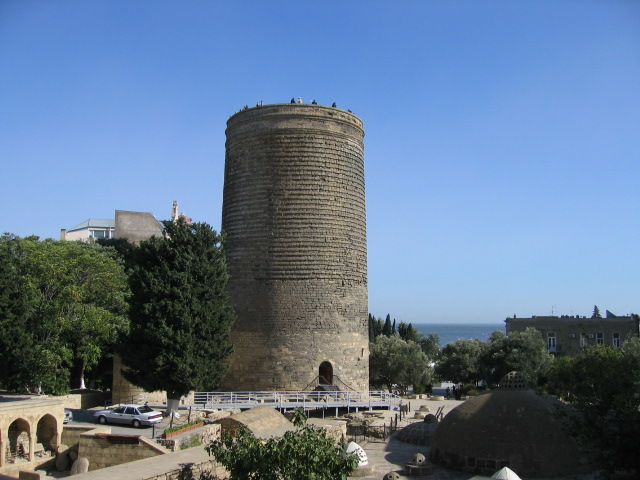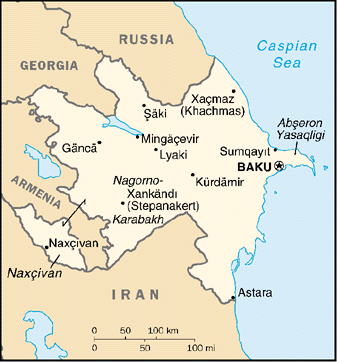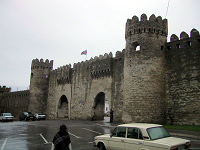 |
www.shejapan.com > World Heritages > The walled city of Baku
Quiz:
|
|
|
|
2. What sea was The maiden tower faced?

Inscribed :2000 Criteria:iv
Brief description:
The Walled City of Baku represents an outstanding and rare example of an historic urban ensemble and architecture with influence from Zoroastrian, Sassanian, Arabic, Persian, Shirvani, Ottoman, and Russian cultures.
 About 12th century, Maiden Tower which was built
into the walled defense system of Baku.
There have been many fluctuations of the sea level of
the Caspian Sea.
It's totally possible that the sea lapped at the tower
in the past although today
it is about one block away.
About 12th century, Maiden Tower which was built
into the walled defense system of Baku.
There have been many fluctuations of the sea level of
the Caspian Sea.
It's totally possible that the sea lapped at the tower
in the past although today
it is about one block away.
 The heavy structure of the Maiden Tower is anchored to
a rock that slopes into the sea.
The structure is 16-16.5 meters in diameter and rises
eight levels to tower above all the buildings
of the old "Inner City" of Baku.
Its architectural plan, seemingly so simple, consists of walls
which at the base are extraordinarily thick,
beginning at five meters in depth and
gradually narrowing to four meters at the top.
On the southern side of the cylindrical-shaped tower are
relatively narrow niches about the height of a man
through which the sun enters to illuminate the inner chambers.
Rather curiously, there appears to be an external door
that opens out to nowhere from the fourth floor.
There is even a slot for a wooden spar,
which seems to have served as a door-lock.
But why on the fourth floor?
The heavy structure of the Maiden Tower is anchored to
a rock that slopes into the sea.
The structure is 16-16.5 meters in diameter and rises
eight levels to tower above all the buildings
of the old "Inner City" of Baku.
Its architectural plan, seemingly so simple, consists of walls
which at the base are extraordinarily thick,
beginning at five meters in depth and
gradually narrowing to four meters at the top.
On the southern side of the cylindrical-shaped tower are
relatively narrow niches about the height of a man
through which the sun enters to illuminate the inner chambers.
Rather curiously, there appears to be an external door
that opens out to nowhere from the fourth floor.
There is even a slot for a wooden spar,
which seems to have served as a door-lock.
But why on the fourth floor?
Legends
Many legends surround the Maiden Tower.
Most of them center around the word-"Maiden."
A young girl, according to most versions, ordered the tower
to be built and then either locked herself in,
or threw herself from its heights into the sea below.
As the level of the Caspian Sea has
experienced cycles of fluctuation-rising and falling-over the centuries,
there is a strong possibility that at one time,
the waves did lap at the Tower although today the sea is
about a block away although it is getting closer and closer again.
According to one of the most popular legends, it was a king,
himself the girl's father,who fell in love with her and wanted to marry her.
But the girl tried to delay her father's advances by begging him
to build the tower and wait until it was completed.
When he completed it, he had still not changed his mind.
That's when she leaped into the sea.
Culturally speaking, specialists believe that the fact
that the story depicts a father wanting to
marry his daughter probably indicates that the legend predates Islam.
Prior to the occupation of Islamic rule in the 7th and 8th century,
experts believe that power was transferred via female lineage
in the region that now is known as Azerbaijan.
To maintain these dynasties, it is believed that
sometimes ritualistic marriages were
arranged between brothers and sisters, and even fathers and daughters.
It is this practice that may be reflected
in these legends that surrounds the Maiden Tower.
Baku, sometimes known as Baky or Baki, is the capital and
the largest city of Azerbaijan. It is located on the southern shore of
the Apsheron Peninsula. Modern Baku consists of three parts: the Old Town,
the boomtown and the Soviet-built town. Population (January 1, 2003 census)
About 3 million people live in metropolitan area.
The layout of the oil-rich city is rectangular, only in the oldest part of
the city within the fortress walls the streets are crooked and narrow.
The boomtown, south of the old city, was built
after massive petroleum exploitation began nearly a century ago and
has interesting beaux-arts architecture. Fine arts,
history and literature museums are located there,
all housed in the mansions of pre-Revolutionary millionaires.
The name Baku is widely believed to be derived from the old Persian names of
the city Badu-kube, meaning "city where the wind blows",
or Baghkuh, meaning "Mount of God". Arabic sources refer the city as Baku,
Bakukh, Bakuya, and Bakuye, all of which seem to come from the original Persian name.
incredible
信じがたい
diameter
直径
Maiden
乙女、処女
Prior
前の、より先に、優先して
peninsula
半島
boomtown
新興都市
crook
曲がった
beaux-arts
美術
Wikipedia The walled city of Baku
Wikipedia Maiden tower
Azerbaijan international
www.shejapan.com
> World
Heritages > The walled city of Baku Copyright(C) 2007, SHEJapan, Ltd. All Rights Reserved.
© 2007 SHEJapan.com